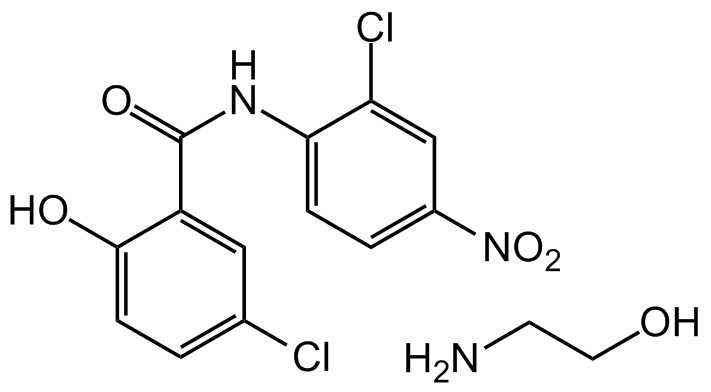
Chemical Structure
Niclosamide . ethanolamine
AG-CR1-3644
CAS Number1420-04-8
Product group Chemicals
Estimated Purity>98%
Molecular Weight327.1 . 61.1
Overview
- SupplierAdipoGen Life Sciences
- Product NameNiclosamide . ethanolamine
- Delivery Days Customer10
- CAS Number1420-04-8
- CertificationResearch Use Only
- Estimated Purity>98%
- Hazard InformationWarning
- Molecular FormulaC13H8Cl2N2O4 . C2H7NO
- Molecular Weight327.1 . 61.1
- Scientific DescriptionChemical. CAS: 1420-04-8. Formula: C13H8Cl2N2O4 . C2H7NO. MW: 327.1 . 61.1. With slightly better solubility properties compared to Niclosamide (Prod. No. AG-CR1-3643). Antihelminthic, molluscicide and trypanocidal agent that inhibits mitochondrial oxidative phosphorylation and anaerobic ATP production. Anticancer agent with antiproliferative activity in a broad spectrum of cancer cells. Targets and inhibits multiple signaling pathways, including STAT3, NF-kB, Wnt/beta-catenin, Notch and mTORC1. Shown to block TNF-alpha-induced IkappaBalpha phosphorylation, translocation of p65 and the expression of NF-kappaB-regulated genes and elevates reactive oxygen species (ROS) levels. Promotes Frizzled1 internalization, down-regulates the expression of Dishevelled-2 protein and inhibits beta-catenin stabilization. Inhibits mTORC1 but not mTORC2 signaling in cells maintained in nutrient-rich conditions. Cell permeable selective STAT3 inhibitor (IC50=0.25microM). Inhibits the activation, nuclear translocation and transactivation of STAT3. Selective over STAT1, STAT5, JAK1, JAK2 and Src kinases. Induces cell cycle arrest, growth inhibition, autophagy and apoptosis. Inhibits S100A4 (Metastasin-1)-induced metastasis in vivo. Inhibits androgen receptor (AR) splice variants. Anti-inflammatory compound. Quorum sensing inhibitor. Broad range antiviral agent that targets acidified endosomes. Antiobesity and antidiabetic agent. Positive allosteric neuropetide Y4 receptor ligand and increases energy expenditure and lipid metabolism through mitochondrial uncoupling. - With slightly better solubility properties compared to Niclosamide (Prod. No. AG-CR1-3643). Antihelminthic, molluscicide and trypanocidal agent that inhibits mitochondrial oxidative phosphorylation and anaerobic ATP production. Anticancer agent with antiproliferative activity in a broad spectrum of cancer cells. Targets and inhibits multiple signaling pathways, including STAT3, NF-kB, Wnt/beta-catenin, Notch and mTORC1. Shown to block TNF-alpha-induced IkappaBalpha phosphorylation, translocation of p65 and the expression of NF-kappaB-regulated genes and elevates reactive oxygen species (ROS) levels. Promotes Frizzled1 internalization, down-regulates the expression of Dishevelled-2 protein and inhibits beta-catenin stabilization. Inhibits mTORC1 but not mTORC2 signaling in cells maintained in nutrient-rich conditions. Cell permeable selective STAT3 inhibitor (IC50=0.25microM). Inhibits the activation, nuclear translocation and transactivation of STAT3. Selective over STAT1, STAT5, JAK1, JAK2 and Src kinases. Induces cell cycle arrest, growth inhibition, autophagy and apoptosis. Inhibits S100A4 (Metastasin-1)-induced metastasis in vivo. Inhibits androgen receptor (AR) splice variants. Anti-inflammatory compound. Quorum sensing inhibitor. Broad-spectrum antiviral agent that targets acidified endosomes. Has been shown to inhibit replication of SARS and is a potential candidate to treat SARS-CoV-2 (COVID-19) infections. Antiobesity and antidiabetic agent. Positive allosteric neuropetide Y4 receptor ligand and increases energy expenditure and lipid metabolism through mitochondrial uncoupling.
- SMILESOC1=CC=C(Cl)C=C1C(NC2=CC=C([N+]([O-])=O)C=C2Cl)=O.NCCO
- Storage Instruction-20°C,2°C to 8°C
- UNSPSC12352200

![Niclosamide olamine [1420-04-8]](https://www.targetmol.com/group3/M00/02/5D/CgoaEWY7K16EBMMOAAAAAE5tmKw894.png)